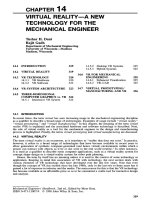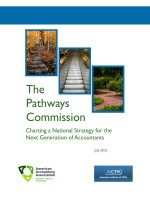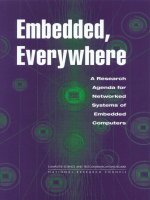Toward a Research Agenda for the Rochester Shooting Database pptx
Bạn đang xem bản rút gọn của tài liệu. Xem và tải ngay bản đầy đủ của tài liệu tại đây (251.17 KB, 18 trang )
Toward a Research Agenda for the Rochester Shooting Database
Working Paper # 2013-04
February 6
th
, 2013
Irshad Altheimer Ph.D.
Janelle Duda
Audrey DiPoala
Karyn Bower
Center for Public Safety Initiatives
Rochester Institute of Technology
585-473-2423
1
Introduction
The aim of this essay is to discuss how the Rochester Shooting Database (RSD) can be utilized to
expand knowledge on shootings and guide violence intervention programs. Gun violence is a serious
problem in the United States. Every year thousands of Americans are shot or killed as a result of gun
violence. The majority of shootings occur in urban areas, and a significant amount of urban shootings
occur in socially disadvantaged neighborhoods where African Americans and Latinos are
disproportionately involved as both offenders and victims. An impressive body of literature exists on this
topic. This research has established the important role that neighborhood characteristics play in shaping
the processes that lead to lethal victimization (Wilkinson, 2003), the contexts in which violent
victimization occurs (Stewart and Simons, 2006), as well as the nature of violent victimization in socially
disadvantaged areas (Kubrin, 2003). Despite these advances, however, important questions remain.
One barrier to expanding knowledge on gun violence in America is the lack of sufficient crime
data to critically assess important empirical questions. Much of the existing research examining violent
crime has utilized self-report or victimization survey data. These data often produce samples that have too
few shooting victims to allow for the separate consideration of shootings, and are unable to provide
characteristics of shooting offenders, victims, or situations. Another area of research on shootings
attempts to identify patterns of shootings across space and time. This research has been critical in
identifying shooting hotspots and linkages between hotspots overtime (see Braga, Papachristos, and
Hureau, 2010), but these analyses often fail to consider possible linkages between hotspots and
characteristics of individuals or situations. The failure to adequately address these issues is not just a
concern for theoretical criminologists. To the extent that public policy should be guided by sound theory,
our failure to understand the nature of these problems may limit our ability to craft adequate solutions to
reduce them.
In an attempt to address some of the shortcomings associated with shooting data, the Center for
Public Safety Initiatives (CPSI) has partnered with the Rochester Police Department (RPD) and the
Monroe Crime Analysis Center (MCAC) to develop the RSD. This essay will discuss how the RSD can
2
be utilized to expand what we know about shootings and guide criminal justice violence interventions.
This paper is divided into three sections. Section One provides a brief introduction to the RSD. Section
Two identifies the key research areas that can be examined with the newly developed dataset. Section
Three discusses the policy implications of the research.
Brief Overview of RSD
The RSD is a collaborative project between CPSI, RPD, and MCAC. Currently in the
developmental stage, the RSD will house data on all shootings that have occurred in the City of Rochester
since 2001. For each shooting incident that involved a death or an injury, data will be collected on the
location of the shooting, the circumstances preceding the shooting, the characteristics of the victim and
the offender, the criminal justice response, and whether or not the victim was killed as a result of the
shooting. It is anticipated that data collection will begin sometime during January 2013. Data collection
will proceed in two steps. First, data will immediately commence for all shootings that occur after January
1, 2013. Second, data will be collected in reverse chronological order for all shootings that have occurred
in the city of Rochester since 2001. Thus data will be collected for shootings that occurred in 2012, then
2011, etc.
Key Research Questions
Development of the RSD has the potential to greatly enhance what we know about inner-city gun
violence. Eleven areas of research will be highlighted here:
1. Individual risk factors and shooting victimization
2. Situational factors that lead to shootings
3. Micro-place characteristics and shootings
4. Neighborhood disadvantage/code of the street and shootings
5. Race/Ethnicity and shootings
6. Gang areas and shooting
3
7. Drug areas and shootings
8. Categorization of shootings
9. Method of shootings
10. Firearm type and shooting outcome
11. Data collection validation
Upon examination of this research, the discussion will turn to how the research findings can be utilized to
develop evidence-based violence prevention strategies in the City of Rochester.
Individual Risk Factors and Shooting Victimization
The first area of interest examines the link between individual characteristics and shooting
victimization. In essence, this research asks if there are certain individual characteristics that predispose
particular individuals to be at greater risk of being the victim of shooting. This research is primarily
guided by lifestyle/opportunity theory. Several variants of opportunity theory exist, but each has
considerable overlap (Cohen and Felson, 1979; Garafolo, 1987; Hindelang, Gottfredson, and Garafolo,
1978).
The basic premise of opportunity theory is that in order for crime to occur potential victims and
motivated offenders must converge in space and time. Therefore, individuals whose recurrent and
prevalent activities place them in closer proximity to motivated offenders are expected to have a high risk
of victimization. According to opportunity theory, lifestyles are shaped by “individuals’ collective
responses or adaptations to various role expectations and structural constraints (Meier and Meithe,
1993:466).” Role expectations and cultural restraints express shared societal expectations about
appropriate behavior for individuals with certain attributes. Adherence to societal expectations leads to
the establishment of routine daily activities for these individuals, thereby influencing their risk for
victimization. For example, a young male who is known to affiliate with gang members will be at a
heightened risk for shooting victimization because he will likely engage in some form of criminal activity,
4
be placed in closer proximity to violent gang members and their rivals, and join congregations of
unsupervised youth in high crime areas.
Situational Characteristics
Situational research is distinct from individual-level research because it focuses on the ongoing
interactions within events rather than the characteristics of the individual. As noted by Short (1995: 42),
this research asks “How did this event occur, and what was the nature of the interaction among event
participants that led to the behavioral outcome of interest?” Focusing on the situation rather than the
individual is important because evidence suggests that situational factors may influence violence separate
from individual characteristics. Understanding the sequence of such events sheds light on the factors that
place both the victim and the offender at greater risk of being engaged in a shooting. For example,
research has documented the role of status threats as key sources of urban violence (Short, 1995; Stewart,
Schreck, and Simons, 2006). It is possible that certain status threats are more likely to lead to violent
retaliation than others. It also seems plausible that particular offenders respond to status threats
differently than others. Short (1995) notes that gang leaders will often use violent responses to external
status threats to solidify their status within the crew or gang. Identifying the processes that that lead to
violent situations can aid in the development of policy interventions that seek to reduce the likelihood of
violent or lethal outcomes.
Micro-Place Characteristics and Shootings
An emerging body of research has begun to examine the concentration of crime at small-
geographic locations or hotspots (Weisburd, Groff, and Yang, 2011). Often the size of a city block or
intersection, these areas are commonly referred to as hotspots or micro-places, and have been found to
exhibit important impacts on city levels of crime. There are several findings from research on micro-
places that are important for the RSD (See Weisburd, Groff, and Yang, 2011). First, this research has
found that a small proportion of street segments in a city—sometimes as small and 3.5 to 5%—account
5
for the more than 50% of all crime (Braga, Papachristos, and Hureau, 2010). Second, hot spots exhibit
variability within and across neighborhoods. Even in high crime neighborhoods crime is not evenly
distributed. Although a greater number of hotspots may exist in high crime neighborhoods, these hotspots
only make up a small proportion of street segments in these neighborhoods and are often adjacent to street
segments with relatively low levels of crime. Third, hot spots appear to be relatively stable across space
and time. Fourth, crime at place is predictable. That is, there are characteristics of micro-places that
provide insight into whether or not they will become a hotspot (Weisburd, Groff, and Yang, 2011;
Bernasco and Block, 2011)
The findings from research on micro-places lead to some tantalizing questions about the nature of
gun violence in Rochester. First, do the spatial dynamics relating to the concentration of shooting
hotspots also hold in Rochester; a city with considerably higher levels of concentrated poverty than some
of the other study cites (i.e. Boston, Seattle)? Relatedly, how do neighborhood characteristics shape the
emergence of crime hotspots? Third, can police lever pulling and other crime reduction strategies focused
at micro-places reduce levels of violence? Fourth, do individual risk factors interact with characteristics
of micro-places to influence gun victimization? If so, can crime be further reduced by suppressing crime
at micro-places and closely monitoring those individuals who are most likely to be victimized at these
locations? Addressing these questions will make it possible to determine the extent that targeting micro-
places can be part of the solution to reducing gun violence in Rochester.
Neighborhood Characteristics
An impressive body of literature exists on the effects of neighborhood characteristics on gun
violence. This research has established the important role that neighborhood characteristics play in
shaping the processes that lead to lethal victimization (Wilkinson, 2003), the contexts in which violent
victimization occurs (Stewart and Simons, 2006), as well as the nature of violent victimization in socially
disadvantaged areas (Kubrin, 2003). Despite these advances, however, important questions remain. Two
initial questions emerge relating to gun violence and the RSD. First, how do neighborhood conditions
6
interact with individual risk factors to influence shooting victimization? A cornucopia of research has
been produced that has examined such interaction effects. Yet little is known about how such interactions
might influence shootings. Because the risk factors of shooting victimization may be unique (see
Wilkinson, 2003), an examination of potential interaction effects is also warranted. Second, do
neighborhood level characteristics and individual level risk factors predict the likelihood that a shooting
will result in death? An expansive literature exists that accounts for weapon-instrumentality effects, but
less attention has been given to the other factors that might increase the lethality of violence. This is in
spite of the fact that research has emerged that suggests that neighborhood conditions might increase the
lethality of certain types of violence (Anderson, 1999).
Race/Ethnicity and Shootings
Understanding neighborhood effects on crime should also shed light on the link between race and
violence. African Americans' disproportionate involvement in crime persists; study after study has
shown that African Americans are significantly more likely to be both victims and perpetrators of violent
crime. Homicide has continued to be the leading cause of death among young black males and black
males are at substantially higher risk of being the victim of murder than their white counterparts (CDC;
NVDRS). This disparity in black and white crime has been explained by Sampson and Wilson's (1995)
racial invariance theory. This theory posits that race is an indicator for a multitude of social contexts
which are variably dispersed throughout the United States, building on the argument that concentrated
neighborhood disadvantage is the greatest predictor of violence. The link between race and crime, then,
is viewed with regard to context rather than solely individual characteristics (also see Peterson and Krivo,
1993). More recent research challenges the racial invariance hypothesis and suggests that cultural
processes moderate the impact of social disadvantage on violence (Martinez, Stowell, and Lee, 2010).
Questions around neighborhood segregation, neighborhood disadvantage, inter-neighborhood
disadvantage and violence, homogeneity, and cultural mechanisms could be addressed through the
shooting database.
7
Gang Involvement
Academics have long studied the impact of gang activity on violent crime. Past research
consistently shows that gang membership and gang associations greatly increase the risk of victimization
by shootings (Papachristos, Braga, and Hureau, 2011; Wallace, 2009). Papachristos et al. (2011) describe
the reality of gun violence concentrated within specific social networks, and that the closer an individual
is socially to this network, the higher the risk for victimization. This occurrence could be partially
explained by the concept of the “code of the street” (Anderson, 1999). Adherence to this code leads one to
reject dependence on law enforcement to settle personal disputes and encourages the person to instead
assume responsibility to settle their own disputes through violence (Ratcliffe and Rengert, 2008). This
quality of street culture is then infused into the values of the street gangs, leading members to extend the
responsibility of protection out to their fellow members. This creates a process by which members use
violent retaliation to respond to a threat or some perceived act of disrespect (Decker and Van Winkle,
1996). This mechanism of violence can be expected to produce ongoing conflict and increased violence as
opposing parties set out to “settle the score” (Ratcliffe and Rengert, 2008).
At the present time, there are several ways law enforcement can follow gang activity. The
Rochester Shooting Database will provide the ability to record and examine all gang-involved shootings
within the city. This will allow the opportunity to trace and link any gang-involved shootings to other
incidents, or other shootings. With this information it may be possible to calculate various characteristics
of gang-involved shootings, such as the average number of retaliatory shootings within a single dispute,
the length of time between retaliations, and the speed and degree of escalation. Using the RSD along with
existing records in crime analysis may aid in the detection of the point of initial conflict, which may guide
law enforcement on where to focus their attention in order to reduce retaliatory shootings.
Drug Areas
It is axiomatic that the presence of open air drug markets in a particular area elevates levels of
crime. Research has established that robbery and homicide rates are higher in cities with higher levels of
8
crack use (Baumer, Lauritsen, Rosenfeld, and Wright, 1998). Relatedly, Blumstein (2000) argued that the
national increase of crime during the mid-1980s was the result of:
introduction of crack in the mid-1980s; recruitment of young minority males to sell the drugs in
street markets; arming of the drug sellers with handguns for self-protection; diffusion of guns to
peers; irresponsible and excessively causal use of guns by young people, leading to a
“contagious” growth in homicide and possibly robbery also. (p. 39)
An additional area of research is concerned with the link between drug markets and the spatial dynamics
of violent crime. One recent study examined the relationship between gang set space—defined as the
actual area within a neighborhood where gang members come together as a gang—and crime counts at
open-air drug markets (Taniguchi, Ratcliffe, and Taylor; 2011). The results suggest that crime counts are
high in areas used for drug distribution and even higher in drug markets occupied by more than one gang.
These results suggest that competition for drug territory fuels violence. Drug areas are ripe for shootings
because the money generated from the drug trade attracts attention of rival criminal groups. Because of
the illegal activity involved, participants have no legal recourse to settle disputes. Research linking drugs
and violence is important for understanding shootings in Rochester because evidence suggests that a
substantial proportion of homicides in Rochester are drug-related (Klofas, 2001). Thus, severing the
drug-violence link is important for reducing shootings in Rochester.
Categorization of shootings
This area deals with the manner that shootings are categorized. Typically, violent crime is
categorized as either expressive or instrumental. Expressive crimes represent acts of violence that occur
as a result anger or frustration generated in response to an event or series of events. Instrumental crimes
are those committed for explicit material gain (Meithe and Regoeczi, 2004). Although these two
categorizations are widely accepted among criminologists, some have questioned the utility of this
taxonomy (Block and Block, 1993; Felson, 1993; Polk, 1994). Meither and Regoeczi (2004) examined
whether expressive and instrumental crimes are fundamentally and qualitatively distinct. Although they
9
found support for the use of this taxonomy, they also found that in the last two decades there has been an
emerging context of drug and gambling related violence among inner-city youth that does not clearly fit
either category.
These findings are important for understanding variation in homicide in Rochester, NY. Klofas
(2001) found that homicides in Rochester largely consist of two types: Drug rip-offs or dispute related
violence. Interestingly, many of these homicides don’t fit neatly into the expressive-instrumental
taxonomy. For instance, 6 of the 17 dispute related homicides that occurred in Rochester in 2000 were
the result of long-running disputes. 2 of the 17 dispute related homicides were the result of a past rip-off
or a past debt. Disputes such as these likely are motivated by both instrumental and expressive factors.
13 of the 18 rip-off homicides were the result of drug house robberies/assassinations. Although these
homicides may seem instrumental on the surface, research has shown that the both instrumental and
expressive motives influence drug homicides. It is possible that the persistent level of homicide in
certain areas of Rochester is the result of disputes that don’t clearly fit into the instrumental/expressive
dichotomy. Understanding the motives of these homicides may take us a step closer to finding solutions
to prevent them.
Method of Shooting
As previously noted, research has shown that the majority of shootings take place in a small
number of locations (Braga, Papachristos, & Hureau, 2010). What is less known is what types of
shootings are more likely to be attracted to certain places. For instance, are the majority of indoor
shootings related to domestic disputes? Are most street corner shootings drug related? Can drive by
shootings usually be linked to gang violence? Does the range from the shooter to the victim indicate any
pattern? What can the circumstances surrounding shootings tell us about why they occur?
Categorizing shootings in this manner may assist the development of effective police practices to address
gun violence. But what can specific methods reveal about the nature of these shootings? The RSD will
enable law enforcement to determine any connections between method of shootings and reasons for why
10
they occur. This will enable police interventions to effectively target the identified problems. Without
information adequate information, police strategies targeting shootings will likely be too broad to be
efficient. The data gathered from the RSD will allow law enforcement to identify specific issues that tend
to lead to gun violence. Existing literature linking methods of shootings to causes and locations is scarce.
Information gathered from the RSD will give law enforcement the opportunity to analyze shootings in a
way that has not been examined in other research
Firearm Type and Shooting Outcome
Certain types of firearms have made for a particularly hot topic in recent discussion. As increased
attention is brought to several shootings involving semi-automatic firearms, the focus on other types of
guns experiences an almost inverse reaction. Federal statistics show that around 70% of firearm
homicides in the U.S. involve handguns, while rifles generally account for about 4% (UCR, 2012). This
raises concern over the actual versus perceived magnitude and frequency of different types of firearms
involved in firearm homicides. Research has consistently found that handguns account for a much larger
percentage of homicide shootings than do shotguns and rifles (Cukier, 1998). In terms of nonfatal
shooting injuries, firearm type is not as commonly studied, yet existing literature points to a consistency
in the predominant use of handguns (Firearm & Injury Center at Penn, 2011). Studying the frequency of
firearm types in both fatal and nonfatal firearm use can lead toward the fact-based formation of policy and
gun regulation. Upon gathering this information and analyzing the data, it may be found that different
types of firearms are used in different types of crimes, disputes, or relationships. Furthermore, it may be
useful to use the information gathered from the database to track the pattern of firearm types being used
across time, which can then lead to increased attention to weapons of interest.
The study of specifics on firearms is found to be even less common than the research on gun type.
Specifics such as caliber, firing action, and capacity are very rarely studied, if even documented. Wright
and Rossi conducted a study in the 1980’s finding that offenders tend to prefer semi-automatic and larger
caliber handguns, and Koper (2007) notes that crime gun preferences may be influenced in part by
11
manufacturing and sales market trends. In either case, marking and tracking the characteristics of
weaponry used in shooting crimes could be very beneficial for focused prevention, investigation, and
appropriate reaction to firearm violence. In relation to both of these concerns, the Rochester Shooting
Database will serve to document known characteristics of firearms used in shootings to support focused
prevention efforts. This information will lead to further research opportunities such as the relationship
between weapon type and level of injury, weapon trends across time, and the correlation of dispute type
and type of firearm used.
Data Collection Validation
Use of technological tools for police problem-solving has increased in recent years
(Watkins, Mazerolle, Rogan, Frank, 2002) and the database has the opportunity to add to this growing
field. Gunshot location technology (e.g. Shotpsotter), closed circuit television, police identification, 911
calls, and hospital reporting are all methods for crime reporting. The shooting database will allow for
validation of data sources on shooting incidents and inform future database development as technology
expands. Comparisons can be made across the varying methods of incident detection. Questions to be
addressed include: how frequently does Shotspotter detect the shootings inputted into the database? What
proportion of shooting incidents is identified through technology? How frequently do various methods of
reporting the same incident occur? Is one method of detection more reliable than others? Are there
differences in the details that are learned dependent on the method of detection?
Criminal justice responses to shootings
The research agenda discussed above sheds light on sound policy interventions that might emerge
from evaluation of the RSD. Such evaluation can lead to evidence-based practices that may reduce levels
of violence in the City of Rochester and are extensible to other locations. The objective of this section is
to briefly spell out some of these policy implications. The first policy implication concerns the link
between individual-risk factors and gun victimization. Interventions of this nature are difficult, because
12
many of the victims of shootings are themselves actively engaged in a lifestyle that puts them directly at
risk of victimization. This fact notwithstanding, one possible solution would be to target individuals who
are identified as having a high risk of gun victimization for interventions that seek to deter behaviors that
are conducive to victimization and that channel them to more conventional activities. Such an
intervention could take multiple forms. One option would involve the use of lever pulling to directly
communicate the consequences of violence for violent actors (i.e. Community Initiative to Reduce
Violence). Another option would involve the use of social interrupters to closely monitor the events of
high-risk individuals in attempt to channel their energies to more conventional activities (i.e. Operation
Cease-Fire).
A second policy intervention that emerges from the discussion above involves identifying those
situations that are most likely to lead to violent or lethal outcomes, and developing interventions to
change the course of these events. For instance, Klofas (2001) has noted that many homicides in the City
of Rochester involve dispute related violence. One policy intervention would involve the collection of
street intelligence to head off serious violent altercations before they take place. For example, police may
receive intelligence that two gang members attacked and badly injured a rival gang member at a local
night club. This information can be used to closely monitor these rival gang members and use lever
pulling and other techniques to prevent the likelihood of retaliatory violence.
This process can be further aided by more precise identification of those categories of shootings
that are most likely to lead to retaliatory violence. It is plausible that certain categories of shootings are
more likely to lead to retaliatory violence and that certain shooting victims are more likely to respond
with retaliatory violence than others. When considering that the majority of shootings in the City of
Rochester are drug or dispute related, and that shooting victims are reluctant to cooperate with police due
to concerns about losing street credibility or fear of having their own criminal exploits revealed, the only
recourse that these victims may feel that they have is to respond to violence with further violence. Thus,
better categorization of shootings represents one aspect of identifying those events that are likely to lead
to further gun violence in the city.
13
The third policy intervention concerns the identification of those micro-places where crime is
most concentrated and development of interventions to suppress crime at these places. As noted above,
Weisburd, Groff, and Yang (2011) found substantial variability in crime across street segments and
established that even high-crime neighborhoods have low-crime street segments. This suggests that
focusing attention on a few shooting hotspots in high crime neighborhoods may be more efficient than
focusing on neighborhoods as a whole. Importantly, there is evidence that reducing shootings at hotspots
can occur without dispersing crime to adjacent street segments (Wyant et al., 2012). Such an approach
will allow targeted law enforcement and social service provision to certain areas while also freeing up law
enforcement resources for other pressing issues. Additionally, targeting high-crime street segments rather
than neighborhoods can reduce friction between police and those who contend that police
indiscriminately target residents of poor minority neighborhoods.
The crime reducing benefits of targeting high-crime street segments may be enhanced further by
closely monitoring high-risk individuals who congregate at high-crime street segments. As noted by
Anderson (1999), certain street corners in high-crime neighborhoods become staging areas where
individuals campaign for respect. These staging areas often become flashpoints for violence, as
individuals use threats or assaults to enhance their street status. The important point to emphasize here is
that for certain street-oriented individuals, shooting someone to settle a dispute may not be sufficient.
The use of violence to settle a dispute may only result in the desired outcome if it occurs at, or in close
proximity to, a staging area. Thus, combining police suppression with lever pulling may lead to an added
reduction of violence, as the potential shooter is deterred and the staging area is no longer a viable
location to commit the shooting.
A final intervention concerns the role of drug markets in shaping crime at hot-spots. For the purposes
of this discussion, drug markets are problematic because of their violence enhancing features. As noted
above, the money generated from drug markets leads to violent competition between rival groups. Thus,
both supply and demand side interventions that target drug dealing at open air drug markets may lead to
reductions in associated violence. One approach might involve a series of strategies that deter drug users
14
from seeking drugs at certain markets. These strategies might involve being pulled over and warned by
police or a mail campaign that targets drivers that stopped and purchased drugs at these corners. When
combined with police suppression, this approach might reduce both drug distribution and related violence
at hot-spots.
15
References
Anderson, E. (1999). Code of the street: Decency, violence, and the moral life of the inner city. New
York, NY: W. W. Norton & Company
Braga, A.A., Papachristos, A.V., and Hureau, D.M. (2010). “The concentration and stability of gun
violence at micro places in Boston, 1980-2008.” Journal of Quantitative Criminology 26:33-53
Baumer, E.P., Lauritsen, J., Rosenfeld, R., and Wright, R. (1998). “The influence of crack cocaine on
robbery, burglary, and homicide rates: A cross-city, longitudinal analysis.” Journal of Research in
Crime and Delinquency 33:316-340.
Bernasco, W., and Block, R. (2011). “Robberies in Chicago: A block-level analysis of the influence of
crime generators, crimes attractors, and offender anchor points.” Journal of Research in Crime
and Delinquency 48(1):33-57
Block, C.R., and Block, R.L. (1993). Street Gang in Crime in Chicago. National Institute of Justice Brief.
Washington D.C.
Blumstein, A. (2000). “Disaggregating violence trends.” Pp. 13-44 in The crime drop in America, edited
by Blumstein, A., and Wallman, J. Cambridge, UK: Cambridge University Press.
Cohen, L.E. and Felson. M. (1979). “Social Change and Crime Rate Trends: A Routine Activity
Approach.” American Sociological Review 44:588-608.
Cukier, W. (1998). Firearm regulation: Canada in the international context. Chronic Diseases in Canada,
19(1), 25-34. Retrieved from />phac/H12-27-19-1E.pdf
Decker, S. H., Van Winkle, B. (1996). Life in the gang: Family, friends, and violence. Cambridge, UK:
Cambridge University Press.
Federal Bureau of Investigation (FBI). (2011). Expanded homicide data table 8: Murder victims by
weapon, 2007-2011. Uniform Crime Reports. Retrieved from />us/cjis/ucr/crime-in-the-u.s/2011/crime-in-the-u.s 2011/tables/expanded-homicide-data-table-8
Felson, R.B. (1993). “Predatory and dispute-related violence: A social interactionist approach.” Pp103-
125 in Routine Activity and Rational Choice, edited by Clark R.V., and Felson, M. New
Brunswick: Transaction Publishers.
Firearm & Injury Center at Penn. (2011). Firearm injury in the U.S. Retrieved from
Garafolo, J. (1987). “Reassessing the Lifestyle Model of Crime Victimization.” Pp. 23-42 in Positive
Criminology, edited by M. R. Gottfredson and T. Hirshchi. Newbury Park, CA: Sage
Publications.
Hindelang, M.J., Gottfredson, M.R., and Garafolo J. (1978). Victims of Personal Crime: An Empirical
Foundation for a Theory of Personal Victimization. Cambridge, Mass: Ballinger Publishing
Company.
16
Klofas. K. (2001). “Three kinds of murder.” Working Paper#2001-4. Retrieved from
Koper, C. S. (2007). Crime gun risk factors: Buyer, seller, firearm, and transaction characteristics
associated with gun trafficking and criminal gun use. National Institute of Justice. Retrieved from
Kubrin, C.E. (2003). “Structural Covariates of Homicide Rates: Does Type of Homicide Matter?” Journal
of Research in Crime and Delinquency 40:139-170.
Papachristos, A. V., Braga, A. A., Hureau, D. M. (2011). Six-degrees of violent victimization: Social
networks and the risk of gunshot injury.
Peterson, R.D., and Krivo, L.J. (1993). “Racial Segregation and Black Urban Homicide.” Social Forces 7
1:1011-1026.
Polk, K. (1994). When men kill: Scenarios of Masculine Violence. New York: Cambridge University
Press
Ramiro, M. Jr., Stowell, J, and Lee, M.T. (2010). “Immigration and crime in an era of transformation: A
Longitudinal analysis of homicides in San Diego neighborhoods, 1980-2000.” Criminology,
48(3): 797-829.
Miethe, T.D., and D. McDowall. (1993). Contextual effects in models of criminal victimization. Social
Forces 71(3):741-759
Meithe, T.D., and Regoeczi, W.C. (2004). Rethinking homicide: Exploring the structure and process
underlying deadly institutions. Cambridge: Cambridge University Press
Ratcliffe, J. H., Rengert, G. F. (2008). Near-repeat patterns in Philadelphia shootings. Security Journal,
21:58-76.
Stewart. E.A. and Simons. R.L. (2010). “Race, code of the street, and violent Delinquency: A multi-level
investigation of neighborhood street culture and individual norms of violence.” Criminology
48(2): 2010
Stewart, E.A., Schreck, C.J., and Simons, R.L., (2006). “’I Ain’t Gonna Let No One Disrespect Me’:
Does the Code of the Street Reduce or Increase Violent Victimization Among African American
Adolescents?” Journal of Research in Crime and Delinquency 43:427-458.
Taniguchi, T.A., Ratcliffe, J.H., and Taylor, R.B. (2011). “Gang set space, drug markets, and crime
around drug corners in Camden.” Journal of Research in Crime and Delinquency 48(3):327-363
Wallace, D.S.L. (2009). Violent delinquency in America: The determinants of carrying firearms among
juveniles: A theoretical comparative analysis. (Doctoral dissertation). Retrieved from The
Department of Sociology, Anthropology and Social Work of the College of Arts and Sciences of
Kansas State University.
Watkins, A. M., Huebner, B, M, & Decker, S. H. (2008). Patterns of gun acquisition, carrying, and use
among juvenile and adult arrestees: Evidence from a high-crime city. Justice Quarterly, 25(4):
674-700.
17
Weisburd, D., Groff, E.R., and Yang, S.M. (2012). The criminology of place: Street segments and our
understanding of the crime problem. Oxford: Oxford University Press
Wells, W., Chermak, S. (2011). Individual-level risk factors for gun victimization in a sample of
probationers. Journal of Interpersonal Violence, 26(11): 2143-2164.
Wilkinson, D.L. 2003. Guns, Violence, and Identity among African and Latino Youth. LFB Scholarly
Publishing.
Wright, J. D., Rossi, P. H., Daly, K. (1983). Under the gun: Weapons, crime, and violence in America.
Hawthorne, NY: Aldine de Gruyter.
Wyant. B.R., Taylor, R.B., Ratcliffe, J.H., Wood, J. (2012). “Deterrence, Firearm Arrests, and Subsequent
Shootings: A micro-level spatio-temporal analysis.” Justice Quarterly 29(4):524-545
Zawitz, M. W. (July 1995). Firearms, crime, and criminal justice: Guns used in crime. Bureau of Justice
Statistics: Selected Findings. Retrieved from
o/sites/default/files/_bojs-guns-used-in-crime.pdf









